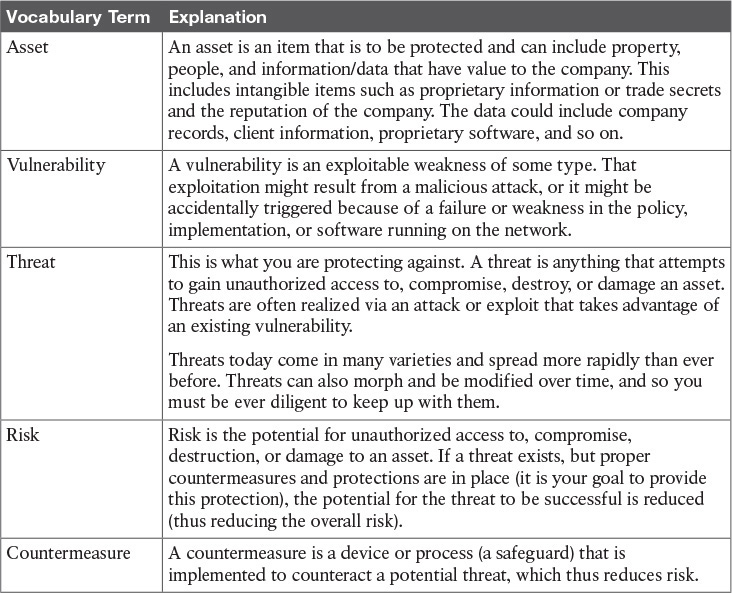Cost-Benefit Analysis of Security
Network security engineers must understand not only what they protect, but also from whom. Risk management is the key phrase that you will hear over and over, and although not very glamorous, it is based on specific principles and concepts related to both asset protection and security management.
What is an asset? It is anything that is valuable to an organization. These could be tangible items (people, computers, and so on) or intangible items (intellectual property, database information, contact lists, accounting info). Knowing the assets that you are trying to protect and their value, location, and exposure can help you more effectively determine the time and money to spend securing those assets.
A vulnerability is an exploitable weakness in a system or its design. Vulnerabilities can be found in protocols, operating systems, applications, and system designs. Vulnerabilities abound, with more discovered every day.
A threat is any potential danger to an asset. If a vulnerability exists but has not yet been exploited or, more importantly, it is not yet publicly known, the threat is latent and not yet realized. If someone is actively launching an attack against your system and successfully accesses something or compromises your security against an asset, the threat is realized. The entity that takes advantage of the vulnerability is known as the malicious actor and the path used by this actor to perform the attack is known as the threat agent or threat vector.
A countermeasure is a safeguard that somehow mitigates a potential risk. It does so by either reducing or eliminating the vulnerability, or at least reduces the likelihood of the threat agent to actually exploit the risk. For example, you might have an unpatched machine on your network, making it highly vulnerable. If that machine is unplugged from the network and ceases to have any interaction with exchanging data with any other device, you have successfully mitigated all of those vulnerabilities. You have likely rendered that machine no longer an asset, though; but it is safer.
Note that thresholds apply to how we classify things. We do not spend more than the asset is worth to protect it because doing so makes no sense. For example, purchasing a used car for $200 and then spending $2000 on a secure garage facility so that nobody can harm the car or $1500 on an alarm system for that car seems to be a fairly silly proposition.
If you identify the data with the greatest value/worth, you usually automatically identify where the greatest effort to secure that information will be. Keep in mind, however, that beyond a company’s particular view about the value of any data, regulatory entities might also be involved (government regulations or laws, business partner agreements, contractual agreements, and so forth).
Just accepting the full risk (the all-or-nothing approach) is not really acceptable. After all, you can implement security measures to mitigate the risk. In addition, those same security devices, such as firewalls and intrusion prevention systems (IPS), can protect multiple devices simultaneously, thus providing a cost benefit. So, you can reduce risk by spending money on appropriate security measures, and usually do a good job of protecting an asset. You can never completely eliminate risk, so you must find the balance.
Table 1-2 describes a number of security terms and the appliances to which they relate.

